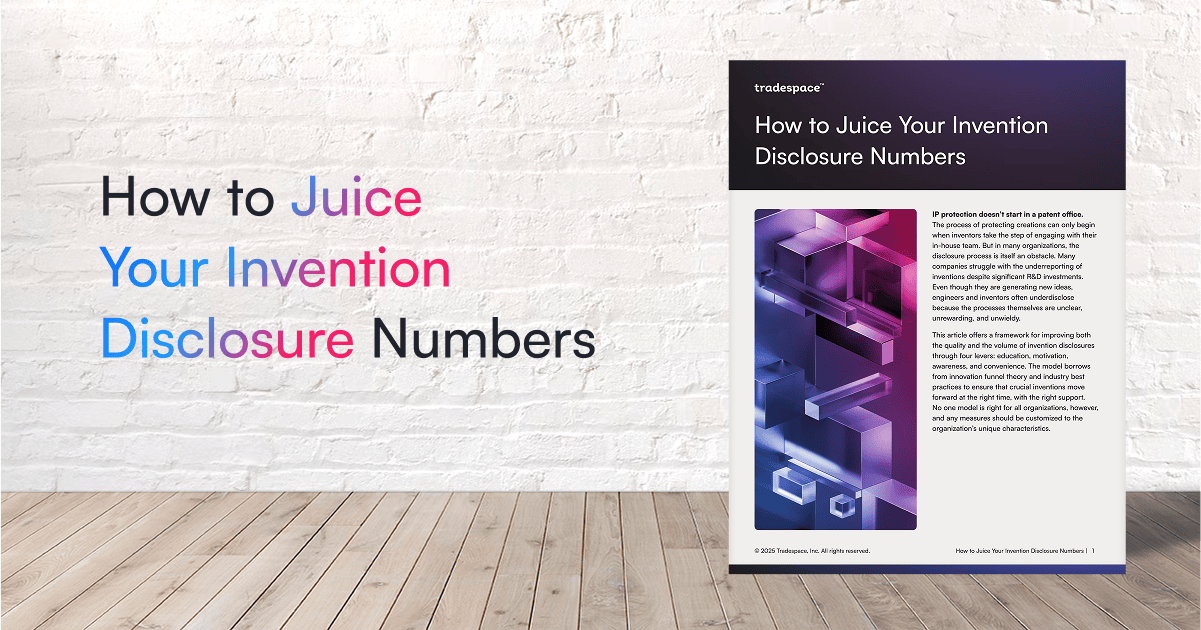3 nuances can help you increase and improve invention disclosures
June 25, 2024 | 5 min readMany of the corporate IP attorneys I’ve talked to lately say they don’t receive enough invention disclosures. Some cite limited “inventor engagement” as the issue, and many worry that their inventors are inventing more than they are submitting. The intellectual property machine is predicated on invention disclosures, so the question becomes: what is IP to do?
The traditional paths to getting inventors to participate in IP are incentives and education. A strategy that I think is underappreciated is improving the disclosure process, and a new paper is beginning to provide evidence for that idea.
Unpacking the Innovator-Inventor Gap: Evidence from Engineers offers insights into “the ‘black box’ process of inventing and the many frictions engineers face in converting innovative ideas to inventions.” According to its findings, only one-third of engineers submit ideas for patenting.
In my experience, IP teams often need help raising inventor awareness and reducing friction in a process the paper calls “far more nuanced and contingent than corporate innovation models acknowledge.” While these solutions are often discussed in theory, I will offer several practical solutions for your consideration. In the rest of this post, I’ll highlight three of these underappreciated nuances and offer introductions on how to approach invention disclosure differently. Using these strategies should better protect company revenue and grow enterprise value, while also potentially helping IP change the underrepresentation of women and minorities in innovation, paper authors Chien and Grennan’s main focus.
Nuance #1: Invention is an ongoing process — disclosure should be too
One of the biggest problems with invention disclosure comes from something I like to call the “rule of hazing inertia.” It says, “I went through it, and so shall you,” dooming us to blindly repeating how we were trained without stopping to say, “Hey, that hurts. Maybe we should do something different.” We all grew up on long invention disclosure forms, with pages of open boxes inviting inventors to write a mini dissertation on their new idea. Congratulations, you just invented something! Now just fill out this little form, and then I’ll invite you to several hours of interviews to pass judgment on your idea.
These painful forms ask inventors to use a structure and language that’s IP’s, not theirs. If an inventor has 80 hours of work to do, they simply aren’t going to fill out a form that takes them several hours. 51% of the engineers Chien and Grennan surveyed said that being too busy prevented them from submitting invention disclosures. Design thinking is a wonderful guide here. If we apply design thinking principles to the invention disclosure process, we are encouraged to use empathy to think about the inventor, not the attorney, and imagine the inventor’s journey through the IP process. Put your inventor hat on for a moment. Would you fill out a traditional invention disclosure form?
Before we even contemplate the role of technology in smoothing this process, consider the simple tweak of asking fewer questions. To get more disclosures, IP could instead focus on getting a high-level, barebones set of information that helps them triage ideas early on. Then, IP can follow up on what’s most interesting, and launch the gauntlet of relevant questions (patent bar, etc) later. This approach makes it more likely that inventors will submit ideas, putting the work of IP on IP, not inventors. Yes, this means more work for the IP team, but our workload hardly matters if inventors aren’t engaged. One of my future posts will consider solutions for the opposite situation: receiving too many disclosures.
Nuance #2: Inventors are often unimpressed with their own inventions (even though the converse is often true too)
Over my IP career, inventors have often downplayed the significance of their inventions, deeming them routine. They had the “curse of knowledge”: what was obvious to them, a highly-talented PhD, was often a breakthrough to others. Inventors are often far beyond a person of ordinary skill in their art, and you might need to remind them.
Chien and Grennan’s surveys suggest that inventors deciding whether ideas are worthy of submission can be a barrier to participating in the IP process. When asked if they were comfortable deciding if their idea is worthy of submitting as an invention disclosure, inventors expressed ambivalence. Only 17% said they’d submit if they were unsure of whether they should submit. Most said they’d seek advice if they were unsure, but not from a patent professional. 8% said they wouldn’t submit an invention disclosure, nor would they seek advice if they were unsure.
Inventors know that they should submit disclosures for inventions, but clearly there’s a disconnect between what inventors think count as inventions and what IP wants to know about. Explicitly making inventors aware of this phenomenon is another way IP can encourage them to submit disclosures even when they’re in doubt. You might have the best invention disclosure process or technology, but it won’t matter if your inventors don’t submit because they are unimpressed with their inventions.
Nuance #3: Don’t treat all your tech staff the same — different inventors need different education
Education is critical for IP, but at the same time, IP attorneys are busy and rarely get the resources they need. So when thinking about education, we need to think about how we can have the biggest impact. In another one of Chien and Grennan’s surveys, only 40% of engineers said they were aware of the process and tools where they can submit an idea for patenting, and only 16% said they had attended an IP training within the last 12 months. Though most IP professionals would find these numbers disappointing or even alarming, don’t fire up an email blast reminding you business of your process and the next training just yet.
According to the Pareto rule, most of your innovation is going to come from a small number of inventors. Keep this rule in mind when educating them. A great way to target when educating under-submitting inventors is to look at the innovation budget and the flow of innovation. Find out where the most R&D budget is going and connect with those teams. Aligning your IP efforts with the company’s strategic priorities ensures that you’re focused on value creation, not just blanketing your R&D organization.
Of course, “different inventors need different education” is also a call for inclusive innovation. Chien and Grennan’s research suggests that when diverse inventors submit ideas, they are of higher quality, and literature suggests that having a diversity of ideas across the board produces higher-quality inventions. As such, another way to reach inventors who might be uniquely poised to create disproportionate value in comparison to their submission history is to provide specialized IP training for affinity groups. Consider, for example, whether your company has a DEI program and explore whether you can partner with them.
This post points to a fundamental paradigm: IP attorneys have to get out of their offices and into the business. If you sit in your chair and wait for your inventors to come to you, you’ll be lonely. In the last survey of Chien and Grennan’s I’ll cite, 25% of engineers said they didn’t realize they could receive advice or feedback from the invention process. It’s up to us to break down the silo between IP and R&D — get out there and shake the tree, something I’ve written about before in my blog, “Three mindset shifts for aligning IP and business.” The leaders that my colleague Marcia, Tradespace’s VP of Client Success, profiles on her IP Storytellers blog exemplify this skill too.



